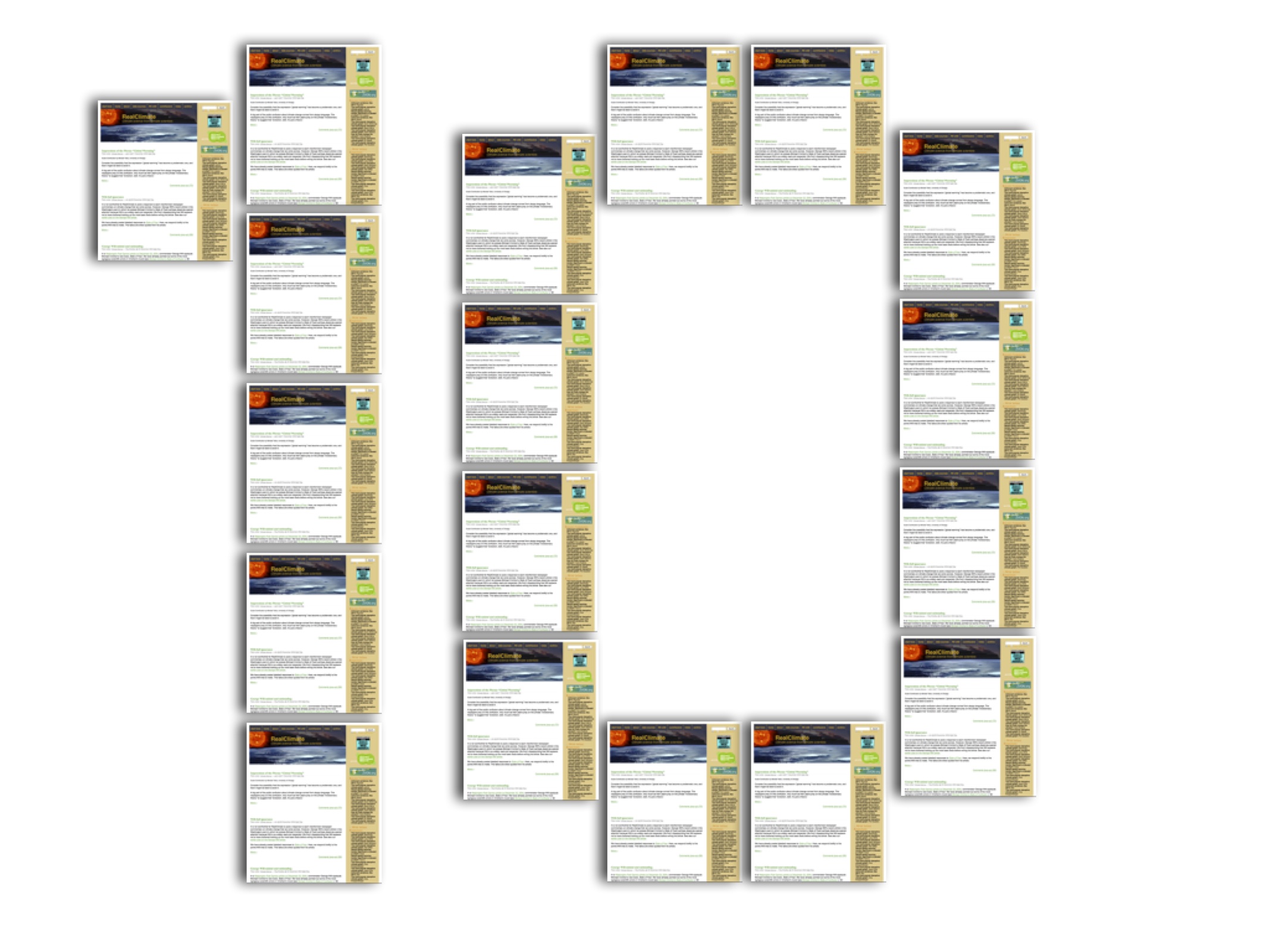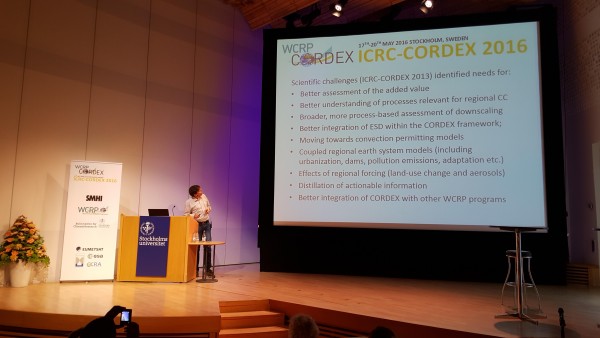There is an interesting news article ($) in Science this week by Paul Voosen on the increasing amount of transparency on climate model tuning. (Full disclosure, I spoke to him a couple of times for this article and I’m working on tuning description paper for the US climate modeling centers). The main points of the article are worth highlighting here, even if a few of the characterizations are slightly off.
Reporting on climate
What is new in European climate research?

What did I learn from the 2016 annual European Meteorological Society (EMS) conference that last week was hosted in Trieste (Italy)?
[Read more…] about What is new in European climate research?
Scientists getting organized to help readers sort fact from fiction in climate change media coverage
Guest post by Emmanuel Vincent
While 2016 is on track to easily surpass 2015 as the warmest year on record, some headlines, in otherwise prestigious news outlets, are still claiming that “2015 Was Not Even Close To Hottest Year On Record” (Forbes, Jan 2016) or that the “Planet is not overheating…” (The Times of London, Feb 2016). Media misrepresentation confuses the public and prevents our policy makers from developing a well-informed perspective, and making evidence-based decisions.
Professor Lord Krebs recently argued in an opinion piece in The Conversation that “accurate reporting of science matters” and that it is part of scientists’ professional duty to “challenge poor media reporting on climate change”. He concluded that “if enough [scientists] do so regularly, [science reporting] will improve – to the benefit of scientists, the public and indeed journalism itself.”
This is precisely what a new project called Climate Feedback is doing: giving hundreds of scientists around the world the opportunity to not only challenge unscientific reporting of climate change, but also to highlight and support accurate science journalism.
Do regional climate models add value compared to global models?
Global climate models (GCM) are designed to simulate earth’s climate over the entire planet, but they have a limitation when it comes to describing local details due to heavy computational demands. There is a nice TED talk by Gavin that explains how climate models work.
We need to apply downscaling to compute the local details. Downscaling may be done through empirical-statistical downscaling (ESD) or regional climate models (RCMs) with a much finer grid. Both take the crude (low-resolution) solution provided by the GCMs and include finer topographical details (boundary conditions) to calculate more detailed information. However, does more details translate to a better representation of the world?
The question of “added value” was an important topic at the International Conference on Regional Climate conference hosted by CORDEX of the World Climate Research Programme (WCRP). The take-home message was mixed on whether RCMs provide a better description of local climatic conditions than the coarser GCMs.
[Read more…] about Do regional climate models add value compared to global models?
Recycling Carbon?
Guest commentary by Tony Patt, ETH Zürich
This morning I was doing my standard reading of the New York Times, which is generally on the good side with climate reporting, and saw the same old thing: an article about a potential solution, which just got the story wrong, at least incomplete. The particular article was about new technologies for converting CO2 into liquid fuels. These could be important if they are coupled with air capture of CO2, and if the energy that fuels them is renewable: this could be the only realistic way of producing large quantities of liquid fuel with no net CO2 emissions, large enough (for example) to supply the aviation sector. But the article suggested that this technology could make coal-fired power plants sustainable, because it would recycle the carbon. Of course that is wrong: to achieve the 2°C target we need to reduce the carbon intensity of the energy system by 100% in about 50 years, and yet the absolute best that a one-time recycling of carbon can do is to reduce the carbon intensity of the associated systems by 50%.
The fact is, there is a huge amount of uncritical, often misleading media coverage of the technological pathways and government policies for climate mitigation. As with the above story, the most common are those suggesting that approaches that result in a marginal reduction of emissions will solve the problem, and fail to ask whether those approaches also help us on the pathway towards 100% emissions reduction, or whether they take us down a dead-end that stops well short of 100%. There are also countless articles suggesting that the one key policy instrument that we need to solve the problem is a carbon tax or cap-and-trade market. We know, from two decades of social-science research, that these instruments do work to bring about marginal reductions in emissions, largely by stimulating improvements in efficiency. We also know that, at least so far, they have done virtually nothing to stimulate investment in the more sweeping changes in energy infrastructure that are needed to eliminate reliance on fossil fuels as the backbone of our system, and hence reduce emissions by 100%. We also know that other policy instruments have worked to stimulate these kinds of changes, at least to a limited extent. One thing we don’t know is what combination of policies could work to bring about the changes fast enough in the future. That is why this is an area of vigorous social science research. Just as there are large uncertainties in the climate system, there are large uncertainties in the climate solution system, and misreporting on these uncertainties can easily mislead us.
It’s fantastic that web sites like Real Climate and Climate Feedback re out there to clear some of the popular misconceptions about how the climate system functions. But if we care about actually solving the problem of climate change, then we also need to work continuously to clear the misconceptions, arising every day, about the strategies to take us there.
Anthony Patt is professor at the ETH in Zurich; his research focuses on climate policy
Marvel et al (2015) Part 2: Media responses
This is a second post related to the new Marvel et al (2015) paper. The first post dealing with the substantive content is here.
What with #AGU15 going on, and a little bit of overlap in content with Shindell (2014), NASA wasn’t particularly keen to put out a press release for the paper, but we did get a ‘web special‘ put out on Friday Dec 18th, the last day of AGU and a few days after the paper appeared online. I’ve been involved with many similar releases for papers and it is always a struggle to concisely say why a paper is interesting while not overselling it or being too technical (which is why only a small fraction of papers get press releases at all).
As we’ve previously remarked about other people’s press releases (eg. Stainforth et al or Willerslev et al), properly calibrating the aspect of a release that will get picked up by the media can be tricky, and so it proved in this case.
[Read more…] about Marvel et al (2015) Part 2: Media responses
References
- K. Marvel, G.A. Schmidt, R.L. Miller, and L.S. Nazarenko, "Implications for climate sensitivity from the response to individual forcings", Nature Climate Change, vol. 6, pp. 386-389, 2015. http://dx.doi.org/10.1038/nclimate2888
Hiatus or Bye-atus?
Guest commentary by Stephan Lewandowsky, James Risbey and Naomi Oreskes
The idea that global warming has “stopped” has long been a contrarian talking point. This framing has found entry into the scientific literature and there are now numerous articles that address a presumed recent “pause” or “hiatus” in global warming. Moreover, the “hiatus” also featured as an accepted fact in the latest IPCC report (AR5). Notwithstanding its widespread use in public and apparent acceptance in the scientific community, there are reasons to be skeptical of the existence of a “hiatus” or “pause” in global warming [Ed: see also this previous post]. We have examined this issue in a series of three recent papers, which have converged on the conclusion that there is not now, and there never has been, a hiatus or pause in global warming.
Debate in the noise
Last week there was an international media debate on climate data which appeared to be rather surreal to me. It was claimed that the global temperature data had so far shown a “hiatus” of global warming from 1998-2012, which was now suddenly gone after a data correction. So what happened?
One of the data centers that compile the data on global surface temperatures – NOAA – reported in the journal Science on an update of their data. Some artifacts due to changed measurement methods (especially for sea surface temperatures) were corrected and additional data of previously not included weather stations were added. All data centers are continually working to improve their database and they therefore occasionally present version updates of their global series (NASA data are currently at version 3, the British Hadley Centre data at version 4). There is nothing unusual about this, and the corrections are in the range of a few hundredths of a degree – see Figure 1. This really is just about fine details. [Read more…] about Debate in the noise
Thoughts on 2014 and ongoing temperature trends
Last Friday, NASA GISS and NOAA NCDC had a press conference and jointly announced the end-of-year analysis for the 2014 global surface temperature anomaly which, in both analyses, came out top. As you may have noticed, this got much more press attention than their joint announcement in 2013 (which wasn’t a record year).
In press briefings and interviews I contributed to, I mostly focused on two issues – that 2014 was indeed the warmest year in those records (though by a small amount), and the continuing long-term trends in temperature which, since they are predominantly driven by increases in greenhouse gases, are going to continue and hence produce (on a fairly regular basis) continuing record years. Response to these points has been mainly straightforward, which is good (if sometimes a little surprising), but there have been some interesting issues raised as well…
[Read more…] about Thoughts on 2014 and ongoing temperature trends
Ten Years of RealClimate: Where now?
 The landscape for science blogging, the public discourse on climate and our own roles in the scientific community have all changed radically over the last 10 years. Blogging is no longer something that stands apart from professional communications, the mainstream media or new online start-ups. The diversity of voices online has also increased widely: scientists blogging and interacting directly with the public via Twitter and Facebook are much more prevalent than in 2004. The conversations have also changed, and (for the most part) have become more nuanced. And a bunch of early career researchers with enthusiasm, time to spare and things to say, have morphed into institute directors and administrators with lots of new pressures. Obviously, blogging frequency has decreased in the last year or so in response to these pressures and this raises the question: where does RealClimate go now?
The landscape for science blogging, the public discourse on climate and our own roles in the scientific community have all changed radically over the last 10 years. Blogging is no longer something that stands apart from professional communications, the mainstream media or new online start-ups. The diversity of voices online has also increased widely: scientists blogging and interacting directly with the public via Twitter and Facebook are much more prevalent than in 2004. The conversations have also changed, and (for the most part) have become more nuanced. And a bunch of early career researchers with enthusiasm, time to spare and things to say, have morphed into institute directors and administrators with lots of new pressures. Obviously, blogging frequency has decreased in the last year or so in response to these pressures and this raises the question: where does RealClimate go now?
